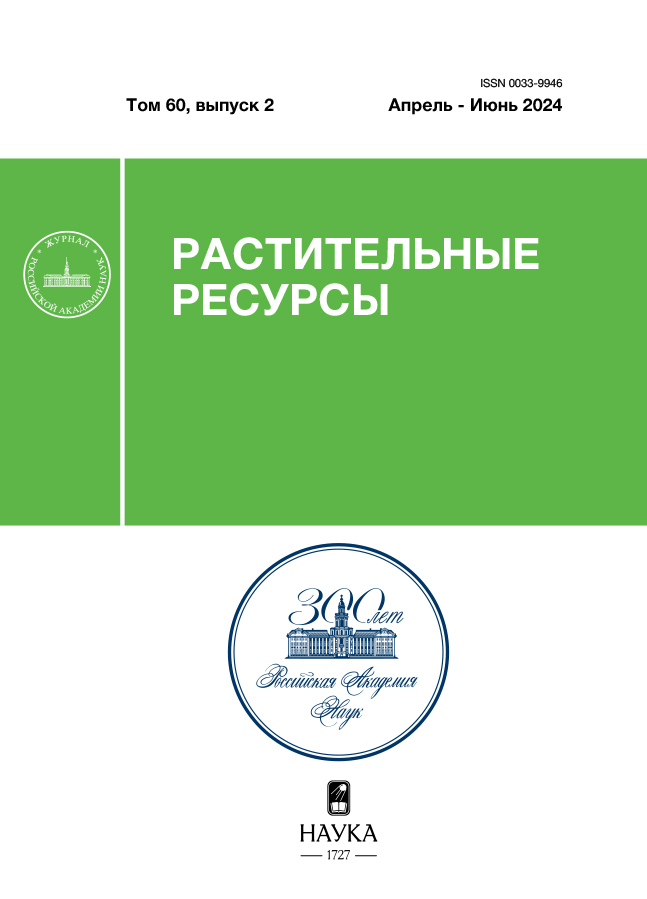Фитохимический анализ плодов Elaeagnus angustifolia (Elaeagnaceae), произрастающего в Астраханской области
- Авторы: Цибизова А.А.1, Генатуллина Г.Н.1, Ясенявская А.Л.1, Самотруева М.А.1
-
Учреждения:
- Астраханский государственный медицинский университет
- Выпуск: Том 60, № 2 (2024)
- Страницы: 113-116
- Раздел: СТАТЬИ
- URL: https://transsyst.ru/0033-9946/article/view/674419
- DOI: https://doi.org/10.31857/S0033994624020084
- EDN: https://elibrary.ru/PYAGLZ
- ID: 674419
Цитировать
Полный текст
Аннотация
Представлены результаты изучения компонентного состава плодов Elaeagnus angustifolia L. (Elaeagnaceae), произрастающего на территории Астраханской области. Выявлено высокое содержание биологически активных веществ: флавоноидов, органических кислот, дубильных веществ, аскорбиновой кислоты, что позволяет сделать вывод о перспективности использования плодов E. angustifolia в качестве основы для разработки лекарственных препаратов.
Полный текст
Об авторах
А. А. Цибизова
Астраханский государственный медицинский университет
Email: yasen_9@mail.ru
Россия, г. Астрахань
Г. Н. Генатуллина
Астраханский государственный медицинский университет
Email: yasen_9@mail.ru
Россия, г. Астрахань
А. Л. Ясенявская
Астраханский государственный медицинский университет
Автор, ответственный за переписку.
Email: yasen_9@mail.ru
Россия, г. Астрахань
М. А. Самотруева
Астраханский государственный медицинский университет
Email: yasen_9@mail.ru
Россия, г. Астрахань
Список литературы
- Chen S. L., Yu H., Luo H. M., Wu K., Li K. F., Steinmetz A. 2016. Conservation and rational use of medicinal plants: problems, progress and prospects. — Chin. Med. 11: 37. https://doi.org/10.1186/s13020-016-0108-7
- Shakya A. K. 2016. Medicinal plants: future source of new drugs. — Int. J. Herb. Med. 4(4): 59—64. https://www.florajournal.com/archives/2016/vol4issue4/PartA/4-2-13-120.pdf
- Süntar I. 2020. Importance of ethnopharmacological studies in drug discovery: role of medicinal plants. — Phytochem. Rev. 19(5): 1199—1209. https://doi.org/10.1007/s11101-019-09629-9
- Сальникова Н. А., Цибизова А. А., Шур Ю. В. 2018. Перспективы применения растений рода Elaeagnus в фармацевтической и пищевой промышленности. — Бюллетень науки и практики. 4(12): 134—147. http://doi.org/10.5281/zenodo.2255667
- Forzaei M. H., Bahramsoltani R., Abbasabadi Z., Rahimi R. 2015. A comprehensive review of the phytochemical and pharmacological aspects of Elaeagnus angustifolia L. — J. Pharm. Pharmacol. 67(11): 1467—1480. https://doi.org/10.1111/jphp.12442
- Сальникова Н. А., Шур Ю. В., Цибизова А. А. 2021. Фитохимический анализ листьев лоха серебристого Elaeagnus argentea. — Разработка и регистрация лекарственных средств. 10(3): 95—99. https://doi.org/10.33380/2305-2066-2021-10-3-95-99
- Nikam F., Azadi A., Barzegar A., Faridi P., Tanideh N., Zarshenas M. M. 2016. Phytochemistry and phytotherapeutic aspects of Elaeagnus angustifolia L. — Curr. Drug. Discov. Technol. 13(4): 199—210. https://doi.org/10.2174/1570163813666160905115325
- Hamidpour R., Hamidpour S., Dustmohamadi P. 2019. Chemistry, Pharmacology and Medicinal Properties of Russian olive (Elaeagnus angustifolia L.). — Cancer. Sci. Res. Open Access. 6(1): 1—7. https://doi.org/10.15226/csroa.2019.00151
- Свечкарь В. П., Буданова Н. А., Григорьева И. В., Пирогова И. М. 2015. Использование валидации в фармацевтической практике на примере определения примесей в спирте этиловом. — Международный журнал прикладных и фундаментальных исследований. 7—2: 263—267. https://applied-research.ru/ru/article/view?id=7006
- Top S. M., Preston S. M., Dukes J. S., Taranil N. 2017. Climate influences the content and chemical composition of foliar tannins in green and aging tissues of Quercus rubra. — Front. Plant Sci. 8: 423. https://doi.org/10.3389/fpls.2017.00423
Дополнительные файлы










